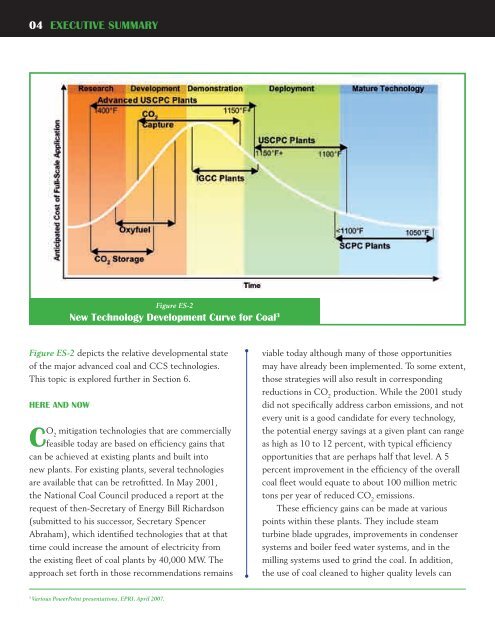Technologies to Reduce or Capture and Store Carbon Dioxide Emissions
TECHNOLOgIEs to Reduce or Capture and store Carbon Dioxide ...
TECHNOLOgIEs to Reduce or Capture and store Carbon Dioxide ...
You also want an ePaper? Increase the reach of your titles
YUMPU automatically turns print PDFs into web optimized ePapers that Google loves.
04 executive summary<br />
Figure ES-2<br />
New Technology Development Curve f<strong>or</strong> Coal 3<br />
Figure ES-2 depicts the relative developmental state<br />
of the maj<strong>or</strong> advanced coal <strong>and</strong> CCS technologies.<br />
This <strong>to</strong>pic is expl<strong>or</strong>ed further in Section 6.<br />
Here <strong>and</strong> Now<br />
C O mitigation technologies that are commercially<br />
2<br />
feasible <strong>to</strong>day are based on efficiency gains that<br />
can be achieved at existing plants <strong>and</strong> built in<strong>to</strong><br />
new plants. F<strong>or</strong> existing plants, several technologies<br />
are available that can be retrofitted. In May 2001,<br />
the National Coal Council produced a rep<strong>or</strong>t at the<br />
request of then-Secretary of Energy Bill Richardson<br />
(submitted <strong>to</strong> his success<strong>or</strong>, Secretary Spencer<br />
Abraham), which identified technologies that at that<br />
time could increase the amount of electricity from<br />
the existing fleet of coal plants by 40,000 MW. The<br />
approach set f<strong>or</strong>th in those recommendations remains<br />
viable <strong>to</strong>day although many of those opp<strong>or</strong>tunities<br />
may have already been implemented. To some extent,<br />
those strategies will also result in c<strong>or</strong>responding<br />
reductions in CO 2<br />
production. While the 2001 study<br />
did not specifically address carbon emissions, <strong>and</strong> not<br />
every unit is a good c<strong>and</strong>idate f<strong>or</strong> every technology,<br />
the potential energy savings at a given plant can range<br />
as high as 10 <strong>to</strong> 12 percent, with typical efficiency<br />
opp<strong>or</strong>tunities that are perhaps half that level. A 5<br />
percent improvement in the efficiency of the overall<br />
coal fleet would equate <strong>to</strong> about 100 million metric<br />
<strong>to</strong>ns per year of reduced CO 2<br />
emissions.<br />
These efficiency gains can be made at various<br />
points within these plants. They include steam<br />
turbine blade upgrades, improvements in condenser<br />
systems <strong>and</strong> boiler feed water systems, <strong>and</strong> in the<br />
milling systems used <strong>to</strong> grind the coal. In addition,<br />
the use of coal cleaned <strong>to</strong> higher quality levels can<br />
3<br />
Various PowerPoint presentations, EPRI, April 2007.


